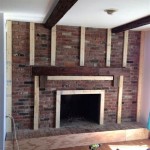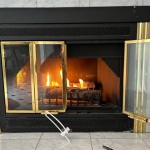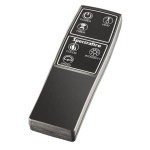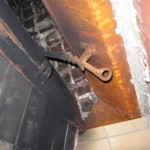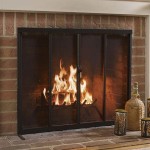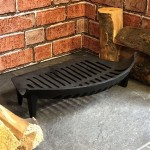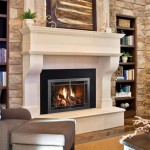Fireplace Corner Mantel Plans: Designing a Central and Stylish Feature
Fireplaces, traditionally a focal point in living spaces, can be further enhanced by the addition of a mantel. A corner fireplace presents a unique architectural challenge and opportunity. Designing a corner mantel requires careful planning and consideration of spatial dynamics, aesthetic preferences, and structural integrity. Fireplace corner mantel plans are essential for achieving a visually appealing and functional addition to a home.
This article will explore key factors to consider when developing fireplace corner mantel plans, encompassing design considerations, material selection, installation techniques, and safety protocols. The intention is to offer a comprehensive understanding of the planning process, enabling informed decision-making for homeowners and professionals alike.
Key Point 1: Design Considerations for Corner Fireplace Mantels
Designing a corner fireplace mantel involves considering several factors that contribute to the overall aesthetic and functionality. The corner location introduces unique spatial considerations that significantly impact design choices. The size and shape of the room, the dimensions of the fireplace itself, and the existing architectural style all play a crucial role in determining the appropriate mantel design.
One of the primary design considerations is the overall style. Mantels can range from traditional and ornate designs to modern and minimalist styles. A traditional mantel often incorporates intricate carvings, decorative molding, and a substantial presence, typically crafted from wood. Modern mantels, conversely, tend to feature clean lines, simplified profiles, and a focus on functionality, often utilizing materials such as metal, concrete, or engineered wood products.
The size and proportions of the mantel should be carefully considered in relation to the fireplace and the surrounding room. A mantel that is too large may overwhelm the space, while one that is too small may appear insignificant. A balanced approach is crucial to creating a harmonious visual effect. Consider the height of the ceiling and the overall scale of the room when determining the mantel's dimensions.
The mantel's depth is also an important consideration. A deeper mantel provides more surface area for displaying decorative items or storing firewood. However, a mantel that is too deep can protrude excessively into the room and create a sense of encroachment. The depth should be proportional to the size of the fireplace and the available space.
Furthermore, the placement of the mantel in relation to the firebox opening is governed by safety regulations and best practices. Building codes typically specify minimum clearances between combustible materials, such as wood mantels, and the firebox opening. These clearances are designed to prevent the risk of fire. Consult local building codes and manufacturer guidelines to ensure compliance.
The corner location necessitates a specific approach to mantel design. A straight mantel may appear awkward in a corner, while a curved or angled mantel can seamlessly integrate with the surrounding walls. Corner mantels can be designed to wrap around the corner, creating a continuous visual line, or they can be designed as separate sections that meet at the corner. The choice depends on the desired aesthetic and the structural considerations of the fireplace.
Consider the functionality of the mantel beyond its decorative role. Will the mantel be used for displaying artwork, photographs, or other decorative items? Will it be used for storing firewood or other fireplace accessories? The intended use will influence the design and construction of the mantel.
Finally, consider the overall aesthetic of the room. The mantel should complement the existing décor and architectural style. Choose materials and finishes that harmonize with the surrounding walls, flooring, and furniture. Color is a key element. A contrasting color can create a focal point, while a complementary color can blend the mantel seamlessly into the room.
Key Point 2: Material Selection and Construction Techniques
The selection of materials for a corner fireplace mantel significantly impacts its aesthetic appeal, durability, and safety. Common materials include wood, stone, brick, metal, and engineered wood products. Each material offers distinct characteristics and requires specific construction techniques.
Wood is a popular choice for fireplace mantels due to its versatility, aesthetic appeal, and relative ease of working. Hardwoods, such as oak, maple, and cherry, offer superior durability and resistance to wear and tear. Softwoods, such as pine and cedar, are more affordable but may require more maintenance. Wood can be stained, painted, or left natural to complement the surrounding décor. When selecting wood, ensure it is properly seasoned and free from knots or defects that could compromise its structural integrity.
Stone and brick are durable and fire-resistant materials that can add a rustic or traditional touch to a fireplace. Stone mantels can be constructed from natural stone, such as granite, marble, or limestone, or from manufactured stone veneer. Brick mantels are typically constructed from clay bricks, which can be painted, stained, or left natural. Stone and brick are heavier than wood and require a strong support structure.
Metal, such as steel or iron, offers a sleek and modern aesthetic. Metal mantels are durable and fire-resistant but can be more challenging to work with than wood. Metal fabrication requires specialized tools and techniques, such as welding and cutting. Metal mantels can be painted, powder-coated, or left with a natural finish.
Engineered wood products, such as MDF (medium-density fiberboard) and plywood, offer an affordable and versatile alternative to solid wood. MDF is smooth and easy to paint, while plywood is strong and durable. Engineered wood products are less prone to warping and cracking than solid wood but are also less resistant to moisture and impact damage.
The construction techniques used to build a corner fireplace mantel depend on the chosen materials and the design complexity. Wood mantels are typically constructed using traditional woodworking techniques, such as joinery, gluing, and screwing. Stone and brick mantels require masonry techniques, such as mortaring and bricklaying. Metal mantels require metalworking techniques, such as welding and cutting.
Regardless of the chosen materials and techniques, it is essential to ensure the structural integrity of the mantel. The mantel must be strong enough to support its own weight and any decorative items placed on it. Use appropriate fastening methods, such as screws, nails, or adhesives, to secure the mantel to the fireplace surround or the surrounding walls. Consider using metal brackets or anchors to provide additional support, especially for heavy mantels.
Adhering to safety regulations is paramount during construction. When working with wood, use appropriate safety gear, such as safety glasses and dust masks. When working with stone or brick, use appropriate safety gear, such as safety glasses, gloves, and a respirator. When working with metal, use appropriate safety gear, such as safety glasses, gloves, and a welding helmet.
Consider potential thermal expansion and contraction of materials. Wood, metal, and stone expand and contract with changes in temperature and humidity. Allow for expansion joints or gaps in the mantel's construction to prevent cracking or warping. Use materials that are resistant to heat and moisture damage, particularly near the firebox opening.
Key Point 3: Installation and Safety Protocols
Proper installation and adherence to safety protocols are crucial for ensuring the longevity and safety of a corner fireplace mantel. The installation process involves securing the mantel to the fireplace surround or the surrounding walls, ensuring adequate clearances from the firebox opening, and verifying the structural stability of the installation.
Before beginning the installation, carefully measure the fireplace opening and the surrounding walls. Verify the dimensions against the fireplace corner mantel plans to ensure a proper fit. Identify the stud locations in the surrounding walls using a stud finder. These studs will provide secure attachment points for the mantel.
Prepare the surfaces to which the mantel will be attached. Clean the surfaces thoroughly to remove any dust, dirt, or debris. If the surfaces are painted or wallpapered, consider removing the paint or wallpaper to ensure a strong bond. Rough up the surfaces using sandpaper to improve adhesion.
Secure the mantel to the fireplace surround or the surrounding walls using appropriate fastening methods. Wood mantels can be attached using screws, nails, or adhesives. Stone and brick mantels require masonry anchors and mortar. Metal mantels can be attached using screws, bolts, or welding.
When attaching the mantel to the surrounding walls, use screws or nails that are long enough to penetrate the studs. Use shims to level the mantel and ensure a flush fit against the wall. Cover the screw heads or nail holes with wood filler or caulk to create a seamless finish.
Maintain adequate clearances between the mantel and the firebox opening. Building codes typically specify minimum clearances for combustible materials near fireplaces. Consult local building codes and manufacturer guidelines to ensure compliance. These clearances are designed to prevent the risk of fire.
Verify the structural stability of the installation. Ensure that the mantel is securely attached to the fireplace surround or the surrounding walls. Test the mantel by applying pressure to various points to ensure that it does not wobble or shift. If the mantel is unstable, reinforce the attachment points or add additional support.
Inspect the installation for any potential hazards. Check for sharp edges, loose fasteners, or protruding objects that could cause injury. Address any hazards immediately. Seal any gaps or cracks around the mantel with fire-resistant caulk to prevent drafts and heat loss.
Before using the fireplace, allow sufficient time for any adhesives or sealants to cure completely. Refer to the manufacturer's instructions for the recommended curing time. Once the installation is complete and the mantel is fully cured, inspect it regularly for signs of damage or wear. Repair any damage promptly to prevent further deterioration.
Consider installing a heat shield or a thermal barrier to protect the mantel from excessive heat. Heat shields are typically made of metal and are designed to deflect heat away from the mantel. Thermal barriers are typically made of fire-resistant materials and are designed to insulate the mantel from heat.
When selecting decorative items to place on the mantel, choose items that are non-combustible and heat-resistant. Avoid placing flammable items, such as candles or dried flowers, near the firebox opening. Keep the mantel clean and free from dust and debris to prevent fire hazards

How To Transform A Corner Fireplace Thrifty Decor Diy And Organizing

How To Build A Faux Diy Corner Fireplace With German Schmear Brick Treatment This Life

32 Best Corner Fireplace Ideas For 2024 Decor Home Gas Living Room Comfy

Arranging Furniture With A Corner Fireplace Brooklyn Berry Designs

How To Make A Corner Fireplace Mantel Look Good 15 Examples

How To Make A Corner Fireplace Mantel Look Good 15 Examples

How To Build A Gorgeous Diy Corner Fireplace Plus Mantel With Storage Remodelaholic

Working With A Corner Fireplace Emily Clark

Diy Fireplaces Our Top Rated Free Project Plans Kreg Tool

How To Build A Gorgeous Diy Corner Fireplace Plus Mantel With Storage Remodelaholic
Related Posts

